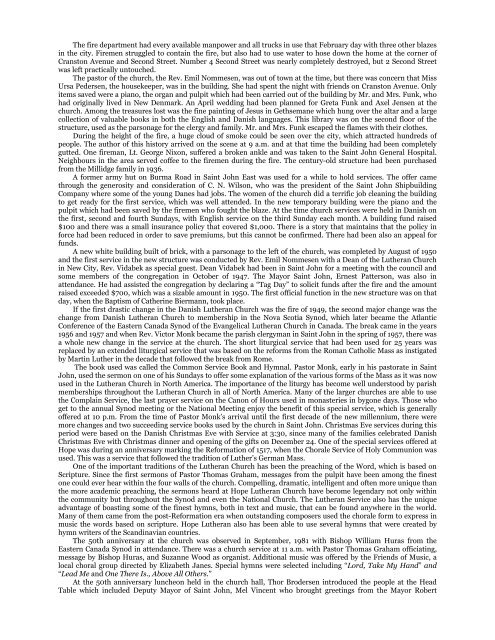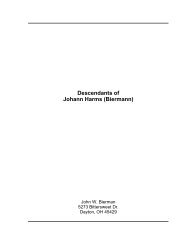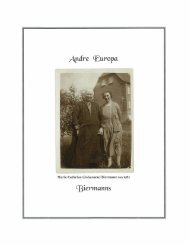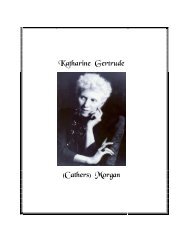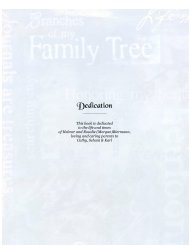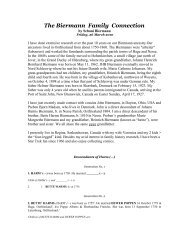A Collection of Dad's Essay's & Writings - Welcome
A Collection of Dad's Essay's & Writings - Welcome
A Collection of Dad's Essay's & Writings - Welcome
You also want an ePaper? Increase the reach of your titles
YUMPU automatically turns print PDFs into web optimized ePapers that Google loves.
The fire department had every available manpower and all trucks in use that February day with three other blazes<br />
in the city. Firemen struggled to contain the fire, but also had to use water to hose down the home at the corner <strong>of</strong><br />
Cranston Avenue and Second Street. Number 4 Second Street was nearly completely destroyed, but 2 Second Street<br />
was left practically untouched.<br />
The pastor <strong>of</strong> the church, the Rev. Emil Nommesen, was out <strong>of</strong> town at the time, but there was concern that Miss<br />
Ursa Pedersen, the housekeeper, was in the building. She had spent the night with friends on Cranston Avenue. Only<br />
items saved were a piano, the organ and pulpit which had been carried out <strong>of</strong> the building by Mr. and Mrs. Funk, who<br />
had originally lived in New Denmark. An April wedding had been planned for Greta Funk and Axel Jensen at the<br />
church. Among the treasures lost was the fine painting <strong>of</strong> Jesus in Gethsemane which hung over the altar and a large<br />
collection <strong>of</strong> valuable books in both the English and Danish languages. This library was on the second floor <strong>of</strong> the<br />
structure, used as the parsonage for the clergy and family. Mr. and Mrs. Funk escaped the flames with their clothes.<br />
During the height <strong>of</strong> the fire, a huge cloud <strong>of</strong> smoke could be seen over the city, which attracted hundreds <strong>of</strong><br />
people. The author <strong>of</strong> this history arrived on the scene at 9 a.m. and at that time the building had been completely<br />
gutted. One fireman, Lt. George Nixon, suffered a broken ankle and was taken to the Saint John General Hospital.<br />
Neighbours in the area served c<strong>of</strong>fee to the firemen during the fire. The century-old structure had been purchased<br />
from the Millidge family in 1936.<br />
A former army hut on Burma Road in Saint John East was used for a while to hold services. The <strong>of</strong>fer came<br />
through the generosity and consideration <strong>of</strong> C. N. Wilson, who was the president <strong>of</strong> the Saint John Shipbuilding<br />
Company where some <strong>of</strong> the young Danes had jobs. The women <strong>of</strong> the church did a terrific job cleaning the building<br />
to get ready for the first service, which was well attended. In the new temporary building were the piano and the<br />
pulpit which had been saved by the firemen who fought the blaze. At the time church services were held in Danish on<br />
the first, second and fourth Sundays, with English service on the third Sunday each month. A building fund raised<br />
$100 and there was a small insurance policy that covered $1,000. There is a story that maintains that the policy in<br />
force had been reduced in order to save premiums, but this cannot be confirmed. There had been also an appeal for<br />
funds.<br />
A new white building built <strong>of</strong> brick, with a parsonage to the left <strong>of</strong> the church, was completed by August <strong>of</strong> 1950<br />
and the first service in the new structure was conducted by Rev. Emil Nommesen with a Dean <strong>of</strong> the Lutheran Church<br />
in New City, Rev. Vidabek as special guest. Dean Vidabek had been in Saint John for a meeting with the council and<br />
some members <strong>of</strong> the congregation in October <strong>of</strong> 1947. The Mayor Saint John, Ernest Patterson, was also in<br />
attendance. He had assisted the congregation by declaring a “Tag Day” to solicit funds after the fire and the amount<br />
raised exceeded $700, which was a sizable amount in 1950. The first <strong>of</strong>ficial function in the new structure was on that<br />
day, when the Baptism <strong>of</strong> Catherine Biermann, took place.<br />
If the first drastic change in the Danish Lutheran Church was the fire <strong>of</strong> 1949, the second major change was the<br />
change from Danish Lutheran Church to membership in the Nova Scotia Synod, which later became the Atlantic<br />
Conference <strong>of</strong> the Eastern Canada Synod <strong>of</strong> the Evangelical Lutheran Church in Canada. The break came in the years<br />
1956 and 1957 and when Rev. Victor Monk became the parish clergyman in Saint John in the spring <strong>of</strong> 1957, there was<br />
a whole new change in the service at the church. The short liturgical service that had been used for 25 years was<br />
replaced by an extended liturgical service that was based on the reforms from the Roman Catholic Mass as instigated<br />
by Martin Luther in the decade that followed the break from Rome.<br />
The book used was called the Common Service Book and Hymnal. Pastor Monk, early in his pastorate in Saint<br />
John, used the sermon on one <strong>of</strong> his Sundays to <strong>of</strong>fer some explanation <strong>of</strong> the various forms <strong>of</strong> the Mass as it was now<br />
used in the Lutheran Church in North America. The importance <strong>of</strong> the liturgy has become well understood by parish<br />
memberships throughout the Lutheran Church in all <strong>of</strong> North America. Many <strong>of</strong> the larger churches are able to use<br />
the Complain Service, the last prayer service on the Canon <strong>of</strong> Hours used in monasteries in bygone days. Those who<br />
get to the annual Synod meeting or the National Meeting enjoy the benefit <strong>of</strong> this special service, which is generally<br />
<strong>of</strong>fered at 10 p.m. From the time <strong>of</strong> Pastor Monk’s arrival until the first decade <strong>of</strong> the new millennium, there were<br />
more changes and two succeeding service books used by the church in Saint John. Christmas Eve services during this<br />
period were based on the Danish Christmas Eve with Service at 3:30, since many <strong>of</strong> the families celebrated Danish<br />
Christmas Eve with Christmas dinner and opening <strong>of</strong> the gifts on December 24. One <strong>of</strong> the special services <strong>of</strong>fered at<br />
Hope was during an anniversary marking the Reformation <strong>of</strong> 1517, when the Chorale Service <strong>of</strong> Holy Communion was<br />
used. This was a service that followed the tradition <strong>of</strong> Luther’s German Mass.<br />
One <strong>of</strong> the important traditions <strong>of</strong> the Lutheran Church has been the preaching <strong>of</strong> the Word, which is based on<br />
Scripture. Since the first sermons <strong>of</strong> Pastor Thomas Graham, messages from the pulpit have been among the finest<br />
one could ever hear within the four walls <strong>of</strong> the church. Compelling, dramatic, intelligent and <strong>of</strong>ten more unique than<br />
the more academic preaching, the sermons heard at Hope Lutheran Church have become legendary not only within<br />
the community but throughout the Synod and even the National Church. The Lutheran Service also has the unique<br />
advantage <strong>of</strong> boasting some <strong>of</strong> the finest hymns, both in text and music, that can be found anywhere in the world.<br />
Many <strong>of</strong> them came from the post-Reformation era when outstanding composers used the chorale form to express in<br />
music the words based on scripture. Hope Lutheran also has been able to use several hymns that were created by<br />
hymn writers <strong>of</strong> the Scandinavian countries.<br />
The 50th anniversary at the church was observed in September, 1981 with Bishop William Huras from the<br />
Eastern Canada Synod in attendance. There was a church service at 11 a.m. with Pastor Thomas Graham <strong>of</strong>ficiating,<br />
message by Bishop Huras, and Suzanne Wood as organist. Additional music was <strong>of</strong>fered by the Friends <strong>of</strong> Music, a<br />
local choral group directed by Elizabeth Janes. Special hymns were selected including “Lord, Take My Hand” and<br />
“Lead Me and One There Is., Above All Others.”<br />
At the 50th anniversary luncheon held in the church hall, Thor Brodersen introduced the people at the Head<br />
Table which included Deputy Mayor <strong>of</strong> Saint John, Mel Vincent who brought greetings from the Mayor Robert


